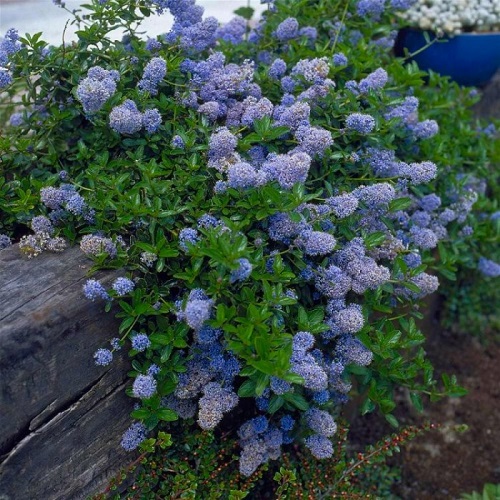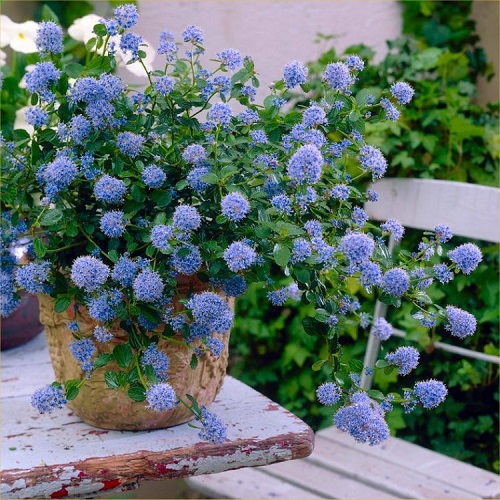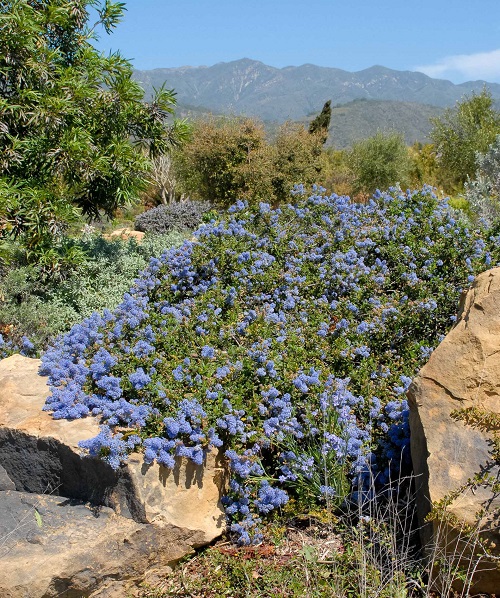Ceanothus Joyce Coulter, also popular as Creeping Mountain Lilac, is a fantastic flowering specimen for gardens!
Wondering How to Grow Ceanothus Joyce Coulter? We’ve got you covered. Read on to learn how to grow and take care of the Creeping Mountain Lilac so you can enjoy its beauty in your garden or landscape.
Botanical Name: Ceanothus ‘Joyce Coulter’
USDA Zones: 7-10
Quince Fruit Tree Care | How to Grow Quince Fruit in a Pot
Ceanothus Joyce Coulter Information
Origin
- Historical Roots: The Ceanothus genus, to which ‘Joyce Coulter’ belongs, has its origins deeply embedded in California’s native flora. These plants have thrived in the state’s diverse ecosystems, from coastal areas to mountainous regions.
- Cultural Significance: Ceanothus plants hold a special place in the hearts of native Californian tribes. Traditionally, various indigenous groups used parts of the plant for medicinal purposes and to create dyes for clothing.
Flowers
- Appearance: The ‘Joyce Coulter’ variety of Ceanothus exhibits exquisite clusters of tiny, delicate blue flowers. These charming blooms are a testament to the plant’s beauty and its contribution to the ecosystem.
- Blossom Time: The Creeping Mountain Lilac bursts into a profusion of blossoms with the oncoming of spring, creating a stunning display of color.
Size
The plant grows upto a height of 4-6 feet with a 1-3 feet of spread.
Propagating Ceanothus Joyce Coulter
Ways to Propagate Ceanothus Joyce Coulter
- Seed Propagation
- Softwood Cuttings
- Hardwood Cuttings
- Layering
- Grafting
- Division
The Most Popular and Reliable Method: Softwood Cuttings
The most popular and reliable propagation method for Ceanothus Joyce Coulter is Softwood Cuttings. This method involves taking young, flexible shoots from the plant and encouraging them to root in a suitable medium. Softwood cuttings tend to root relatively quickly, and they have a high success rate when done correctly.
Steps to Grow Ceanothus Joyce Coulter from Softwood Cuttings:
- Choose Healthy Shoots: Select healthy and disease-free shoots from the parent Ceanothus Joyce Coulter plant during its active growth phase (typically early summer).
- Prepare the Cuttings: Use a clean, sharp pruning tool to take cuttings just below a leaf node. Remove lower leaves, leaving only a few leaves at the tip.
- Optional Rooting Hormone: Dip the cut end of the cutting into the rooting hormone to encourage root development (optional step).
- Prepare Rooting Medium: Fill a container with a well-draining rooting medium like perlite and peat moss.
- Plant the Cuttings: Insert the cut end of the cutting into the rooting medium, burying at least one or two nodes. Gently press the medium around the cutting to secure it.
- Create Humidity: Cover the container with a clear plastic bag or a plastic dome to maintain high humidity around the cuttings.
- Monitor and Transplant: Place the container in bright, indirect light and keep the rooting medium consistently moist.
Once roots are well-developed, transplant the rooted cuttings into individual pots or a suitable garden location.
Propagate Any Plant Cutting Quickly Using this Trick
Advantages of Softwood Cuttings:
- High Success Rate: Softwood cuttings have a relatively high success rate compared to other propagation methods. The young, flexible shoots root quickly and establish themselves well, leading to healthy new plants.
- Maintain Desired Traits: When you propagate through softwood cuttings, the new plants will inherit the exact traits and characteristics of the parent plant, ensuring consistency in flower color, growth habits, and other desirable features.
- Cost-Effective: Growing Ceanothus Joyce Coulter through softwood cuttings can be cost-effective, as it eliminates the need to purchase new plants. You can propagate multiple plants from a single healthy parent plant, expanding your garden or landscape without significant expenses.
Note: You can grow Ceanothus Joyce Coulter from seeds, but this method might be less reliable compared to other propagation techniques like softwood cuttings. Seed germination can be variable, and the resulting plants may not necessarily exhibit the exact characteristics of the parent plant.
Choosing a Container for Ceanothus Joyce Coulter
Selecting the right container is crucial to ensure the healthy growth of your Ceanothus Joyce Coulter in a pot. Consider these factors when choosing a container:
- Size: Opt for a container that provides ample space for the plant’s root system to grow. A container with a diameter of at least 12-16 inches and a similar depth is suitable for accommodating the Ceanothus Joyce Coulter comfortably.
- Material: Choose a container material that suits your preferences and the plant’s needs. Plastic and fiberglass containers are lightweight and retain moisture well, whereas ceramic or terracotta pots can provide a more traditional and aesthetically pleasing look.
- Drainage: Proper drainage is essential to prevent waterlogged soil, which can lead to root rot. Ensure that the chosen container has multiple drainage holes at the bottom to allow excess water to escape.
Note: Keep in mind that Ceanothus ‘Joyce Coulter’ prefers well-draining soil and can become stressed if its roots sit in standing water.
Here are Plant Pot Sizes from Inches to Gallon
Requirements for Growing Ceanothus Joyce Coulter
To ensure the successful growth and thriving beauty of Ceanothus Joyce Coulter, certain key requirements need to be met in terms of sunlight, soil, water, and climate.
Sunlight
- Intensity: Ceanothus Joyce Coulter thrives in full sun, requiring 6-8 hours of direct sunlight daily.
- Protection: While these plants love sunlight, providing some shade during the hottest parts of the day benefits young specimens. With maturity, they become more tolerant of full sun exposure.
Soil
- Type: Well-draining soil is essential for Ceanothus Joyce Coulter. Loamy or sandy loam soils are particularly suitable, as they prevent waterlogged conditions.
- pH Level: Maintaining a slightly acidic to neutral pH range of 6.0 to 7.5 is ideal.
- Fertility: Enhance soil fertility by incorporating well-decomposed compost or organic matter before planting. This enriches the soil, providing necessary nutrients for the young plant’s establishment.
- Depth: Opt for a deep soil bed, considering the plant’s strong taproot. When using containers, prioritize depth over width for optimal root growth.
Watering
- Frequency: Regular watering is vital, especially for young Ceanothus Joyce Coulter plants. Once established, they tolerate some drought but benefit from consistent moisture.
- Method: Deep watering is preferable over frequent shallow watering. This practice encourages deeper root development, enhancing the plant’s resilience to drought.
Temperature
- Hardiness: Ceanothus Joyce Coulter is relatively hardy and can withstand winter temperatures. It’s typically suitable for USDA hardiness zones 7-10.
- Bloom Sensitivity: While the plant itself is hardy, its blossoms can be vulnerable to late spring frosts. Optimal locations shielded from cold winds and late frosts are beneficial.
These plants thrive in temperate climates with distinct seasons. They appreciate the dormancy of winter, followed by the warmth of spring and summer, promoting growth and flowering.
Ceanothus Joyce Coulter Care
Fertilizer
Proper fertilization is essential to ensure the vibrant bloom and health of your Ceanothus ‘Joyce Coulter’. Here’s a simplified guide to fertilizing this plant, whether it’s growing in the ground or in a container.
In-Ground Planting
- Frequency: Ceanothus ‘Joyce Coulter’ planted in the ground typically doesn’t require regular fertilization. Once a year, usually in early spring, is sufficient.
- Type of Fertilizer: Use a balanced, slow-release fertilizer, like a 10-10-10 (N-P-K) formula.
- Method: Sprinkle the granular fertilizer around the base of the plant, about 6-12 inches away from the stem, then water it in. Ensure that the fertilizer doesn’t touch the plant directly to prevent burning.
Container Planting
- Frequency: Plants in containers might require more frequent fertilization, usually twice a year – once in early spring and once in mid-summer.
- Type of Fertilizer: Use a balanced, liquid fertilizer for container plants. Again, a 10-10-10 ratio is recommended. Liquid fertilizers are more readily absorbed in containers.
- Method: Mix the liquid fertilizer with water as per the package instructions. Water the plant with this solution, ensuring that the entire root zone gets wet.
13 Things that Come from Your Blender that Can Fertilize Your Plants
Special Considerations
While Ceanothus ‘Joyce Coulter’ isn’t particularly demanding, it’s essential to avoid over-fertilizing. This plant is adapted to thrive in low-fertility soils. Over-fertilization can reduce bloom and make the plant more susceptible to diseases. If your soil is already rich or if you’re using enriched potting mixtures, you might even skip fertilization for the year.
Always remember, when it comes to fertilizing, less is often more with Ceanothus ‘Joyce Coulter’. Monitor the plant’s growth and adjust your fertilization practices accordingly.
Note: For container plants, use a balanced liquid fertilizer, diluted to 1/2 of its strength, once in 4-5 weeks.
Mulching
Apply organic mulch such as straw, wood chips, or shredded bark around the base of the tree. Ensure the mulch does not directly touch the trunk to prevent rot.
A recommended depth of 2-4 inches helps retain soil moisture, regulate temperature, and suppress weed growth.
Pruning
Maintain an open canopy by pruning Ceanothus Joyce Coulter. This enhances sunlight penetration and air circulation, reducing disease incidence.
Remove dead, diseased, or crossing branches when spotted. Regular maintenance supports the plant’s health and aesthetics.
Pests
- Codling Moth: These pests lay eggs on fruits, leading to larvae burrowing inside, causing damage and rendering fruits inedible.
- Thrips: Tiny insects that feed on leaves of the plant, causing silvering, distortion, and stippling, and they can also transmit viruses.
- Aphids: Tiny insects that feed on tender shoots and leaves, weakening the plant and causing distorted growth and yellowing leaves.
- Whiteflies: Small, winged insects that congregate on the undersides of leaves of the plant, sucking sap and causing yellowing, wilting, and sticky honeydew residue.
Diseases
- Powdery Mildew: A fungal disease that appears as white, powdery spots on leaves, causing them to curl and distort. It can weaken the plant and affect its health.
- Leaf Spot: This disease causes dark spots or lesions on the leaves, leading to discoloration and defoliation. It’s often caused by various fungal pathogens.
- Canker: Cankers are sunken, dead areas on stems and branches caused by fungal infections. They can weaken the plant’s structural integrity and lead to dieback.
- Anthracnose: Another fungal disease that causes irregular, sunken lesions on leaves, stems, and fruits. It can lead to defoliation and reduced fruit production.
FAQs
1. What Is the Best Way to Protect My Ceanothus Joyce Coulter From Pests?
To protect your Ceanothus ‘Joyce Coulter’ from pests like Codling Moth, Thrips, Aphids, and Whiteflies, utilize pheromone traps, organic insecticides, neem oil, insecticidal soaps, traps, insect nets, and bird netting as appropriate. Regular monitoring and early intervention can help keep pests under control.
2. Can Ceanothus Joyce Coulter Be Grown in Containers?
Yes, Ceanothus ‘Joyce Coulter’ can be grown in containers, but there are a few considerations. Choose a larger container with adequate drainage and use a well-draining potting mix. Ensure the container has sufficient space for the plant’s root system to develop. Regular monitoring of soil moisture and proper fertilization will be essential for container-grown plants.
3. How Can I Attract Pollinators to My Ceanothus Joyce Coulter Plant?
To attract pollinators to your Ceanothus ‘Joyce Coulter’ plant, consider planting companion plants that provide nectar and habitat for bees, butterflies, and other pollinators. Flowers like lavender, salvia, and native wildflowers can help create a pollinator-friendly environment. Avoid using harmful pesticides that might deter pollinators, and provide a water source for them as well.






